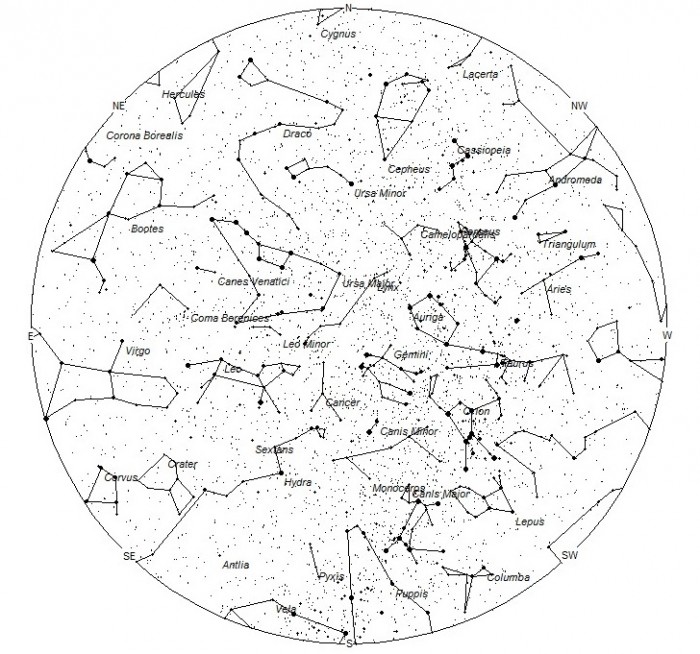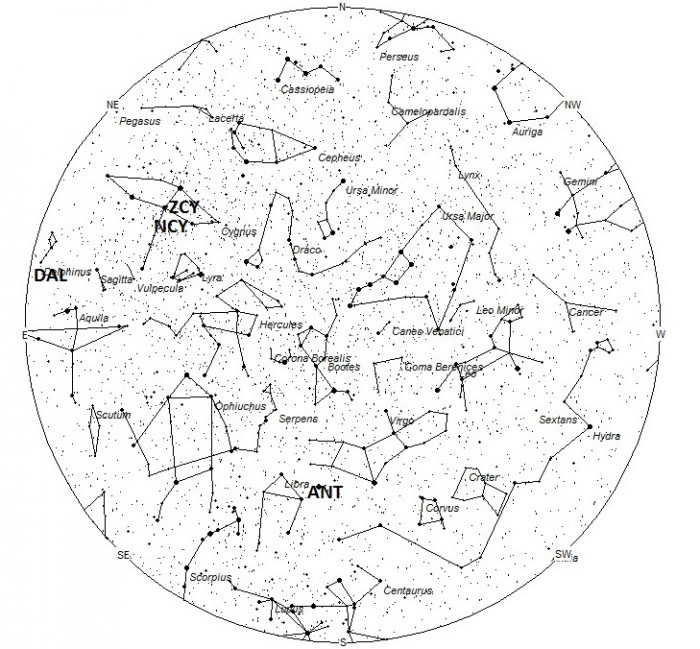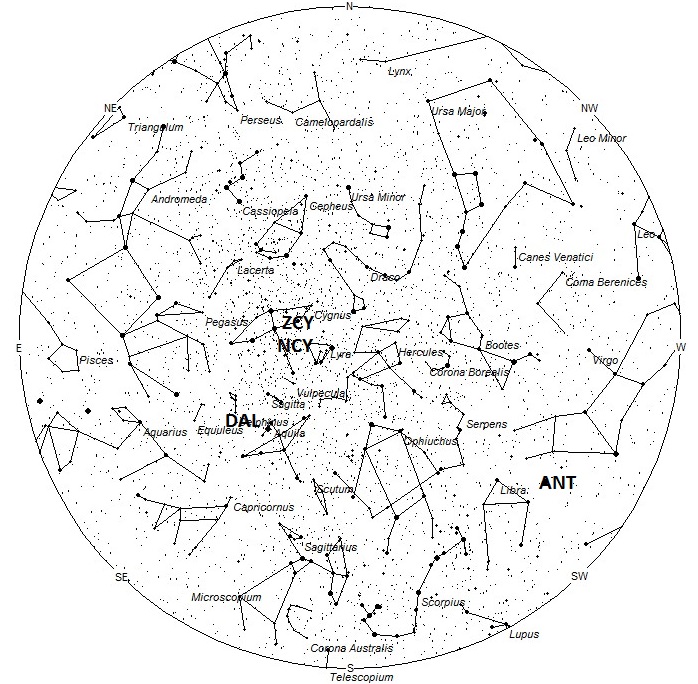During this period the moon reaches its new phase on Wednesday April 10th. At this time the moon is located near the sun and is not visible at night. This weekend the waning crescent moon will rise during the late morning hours but will be too thin to be much of a problem to meteor observers. The estimated total hourly meteor rates for evening observers this week is near three as seen from the northern hemisphere and four as seen from south of the equator. For morning observers the estimated total hourly rates should be near eight from the mid-northern hemisphere and twelve from the mid-southern hemisphere. The actual rates will also depend on factors such as personal light and motion perception, local weather conditions, alertness and experience in watching meteor activity.
The radiant (the area of the sky where meteors appear to shoot from) positions and rates listed below are exact for Saturday night/Sunday morning April 6/7. These positions do not change greatly day to day so the listed coordinates may be used during this entire period. Most star atlases (available at science stores and planetariums) will provide maps with grid lines of the celestial coordinates so that you may find out exactly where these positions are located in the sky. A planisphere or computer planetarium program is also useful in showing the sky at any time of night on any date of the year. Activity from each radiant is best seen when it is positioned highest in the sky, either due north or south along the meridian, depending on your latitude. It must be remembered that meteor activity is rarely seen at the radiant position. Rather they shoot outwards from the radiant so it is best to center your field of view so that the radiant lies at the edge and not the center. Viewing there will allow you to easily trace the path of each meteor back to the radiant (if it is a shower member) or in another direction if it is a sporadic. Meteor activity is not seen from radiants that are located below the horizon. The positions below are listed in a west to east manner in order of right ascension (celestial longitude). The positions listed first are located further west therefore are accessible earlier in the night while those listed further down the list rise later in the night.
The following showers are expected to be active this week:
The large Anthelion (ANT) radiant is currently located at 14:00 (210) -12. This position lies in southeastern Virgo, very close to the position now occupied by the zero magnitude planet Saturn. These meteors may be seen all night long but the radiant is best placed near 0200 Local Daylight Time (LDT) when it lies on the meridian and is highest in the sky. Rates at this time should be near two per hour no matter your location. With an entry velocity of 30 km/sec., the average Anthelion meteor would be of slow velocity.
The Zeta Cygnids (ZCY) are active from March 22 through April 10, with maximum activity occurring on the morning of April 6th. This stream was first noticed by Z. Sekanina in a study of radio meteor streams. It has been recently verified in the IMO video database producing low activity during late March and early April. The radiant is currently located near 20:00 (300) +41. This position lies in western Cygnus, four degrees west of second magnitude Sadr, (Gamma Cygni). The radiant is best placed in a dark sky just before dawn. At 45km/sec. this shower would produce meteors of medium velocity.
Studies of the IMO video database by Sirko Molau and Juergen Rendtel has revealed a weak radiant active in the constellation of Cygnus this time of year. The Nu Cygnids (NCY) are active from April 2 through May 4 with maximum activity occurring on April 18. The current radiant position lies at 20:08 (302) +36. This position lies in central Cygnus, three degrees northeast of the fourth magnitude star known as Eta Cygni. This position is close to that of the Zeta Cygnid radiant so care must be taken to differentiate between the two showers. No matter your location, rates at this time are expected to be less than one per hour. At 42km/sec. the Nu Cygnids would produce meteors of average velocity.
The Delta Aquiliids (DAL) are active from April 5 through through the 13th, with maximum activity occurring on the morning of 11th. This stream was first noticed by Peter Jenniskens and is mentioned in his book Meteor Showers and their Parent Comets. It has been recently verified in the IMO video database producing low activity during the period mentioned above. The radiant is currently located near 20:24 (306) +11. This position actually lies in southwestern Delphinus, two degrees west of fourth magnitude star Epsilon Delphini. The radiant is best placed in a dark sky just before dawn. Rates are expected to be less than one per hour, even at maximum activity. At 66km/sec. this shower would produce meteors of swift velocity.
As seen from the mid-northern hemisphere (45N) one would expect to see approximately five sporadic meteors per hour during the last hour before dawn as seen from rural observing sites. Evening rates would be near two per hour. As seen from the mid-southern hemisphere (45S), morning rates would be near ten per hour as seen from rural observing sites and three per hour during the evening hours. Locations between these two extremes would see activity between the listed figures.
The table below presents a condensed version of the expected activity this week. Rates and positions are exact for Saturday night/Sunday morning .
| SHOWER | DATE OF MAXIMUM ACTIVITY | CELESTIAL POSITION | ENTRY VELOCITY | CULMINATION | HOURLY RATE | CLASS |
| RA (RA in Deg.) DEC | Km/Sec | Local Daylight Time | North-South | |||
| Anthelions (ANT) | – | 14:00 (210) -12 | 30 | 02:00 | 2 – 2 | II |
| Zeta Cygnids (ZCY) | Apr 06 | 20:00 (300) +41 | 45 | 08:00 | <1 – <1 | IV |
| Nu Cygnids (NCY) | Apr 18 | 20:08 (302) +36 | 42 | 08:00 | <1 – <1 | IV |
| Delta Aquiliids (DAL) | Apr 11 | 20:24 (306) +11 | 42 | 08:00 | <1 – <1 | IV |
 American Meteor Society
American Meteor Society


